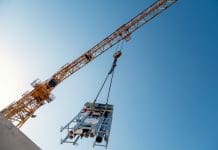Bryan Christiansen, CEO at Limble CMMS, takes a look at how modern technology, particularly the use of the Internet of Things (IoT), is revolutionising the construction industry
Just as every other industry is being transformed by the digital revolution, the construction industry is no exception. Savvy construction companies can benefit by adopting Internet of Things (IoT) and other modern technology.
We are already seeing some signs of this fact.
For example, the top 49% of leading companies (in all sectors) invest more in digital than their counterparts, while 90% of lagging companies invest less in digital than their counterparts.
Naturally, the innovative technology should not be installed for technology’s sake; it should be solving a specific problem. Let’s examine some potential technologies that could benefit the construction industry, and the corresponding problems that they would solve.
Drones
One potential area for adopting some new technology in construction is drone inspections. Facilities in industries such as power and oil & gas have already begun the adoption of drones. By using drones, they can conduct lengthy inspections via remote camera.
This technique saves time and reduces the risk for inspectors, who have had to conduct these on foot in the past. Drones can also easily reach heights that are dangerous to people, eliminating the need for an inspector to climb large ladders/scaffolding, use harnesses, bucket lifts, and the like. Reducing hazardous work for employees is always a plus.
Worker safety
Speaking of hazardous work, the safety of construction workers has always been a huge concern. Now with IoT, we can ensure that critical safety measures are being properly followed. Safety checklists can be integrated into workflow software, guaranteeing that essential safety tasks are completed (rather than “pencil whipped”).
Furthermore, IoT devices can monitor worker vitals in real time and send alerts if thresholds are broken, potentially saving lives and money in the process. In hotter climates, temperatures can be monitored, and sensors can inform whether or not workers should be taking breaks. For vehicles, collision detection has been utilized for several years already and has helped drive down vehicle accidents.
3D modelling and precision measurement
Technology in this space has advanced very rapidly. Companies such as Bentley can quickly provide an accurate 3D model of an existing space, making design faster and easier. The ease and low cost of such software platforms makes them viable for anyone to use. With these models, it becomes much easier to develop 3D models of a project and maintain those files for future projects. The models can later be used for training or simulations (i.e. the “Digital Twin”).
Asset tracking
Have you ever been at a worksite and wasted a good chunk of time looking for that special tool? Asset tracking technology such as RFID can eliminate this problem. A simple software platform could quickly find the asset in question.
For larger sites, locations of fleet vehicles could be extremely beneficial and could help to drive down costs. Worker tracking is another potential use case. All these benefits could be hard to quantify with a monetary value, but any experienced construction professional would know that they are worthwhile. Again, the low cost of such a program makes the hurdle lower for approval.
Predictive maintenance
Of course, a discussion on IoT would not be complete without mentioning predictive maintenance. A predictive maintenance program should begin with an understanding of condition-based maintenance principles.
Predictive maintenance can go in many directions. In an ideal case, equipment would never break down because any potential breakdowns would be predicted by software that is fed with sensors. Important equipment would be prioritized first, with the goal of downtime elimination as the target(maintenance spend should be considered, but only as a secondary measure).
Thus, in most cases, the equipment at greatest risk to cause the downtime and delays to the construction project should be considered first. Failure modes should be studied, as well as fit with existing systems. As more predictive maintenance tasks are completed, the overall cost of maintaining equipment should decrease.
Additionally, predictive maintenance should minimize the occurrence of costly scheduled downtimes and ensure you don’t have any delays caused by malfunctioning equipment.
Augmented reality
The skills gap was discussed in 2018 and will remain a hot issue in the following years. One way to help close this gap is through technology. The use of Augmented Reality (AR) can be employed in many instances to help this area.
Imagine a worker who can see their procedures easily and clearly through AR technology. On construction sites, there is often much time spent checking and rechecking the master prints to ensure the build is accurate. Of course, nobody wants to make a mistake.
With AR, the building prints could be viewed through a lens and workers could quickly confirm the work they were doing was accurate. Modern workers have grown of age surrounded by technology, and they will be able to manage technology in their workplace.
Construction-integrated manufacturing
In an interesting article, Kenny Ingram of IFS discusses how all of the above trends are creating opportunities in Construction-Integrated Manufacturing (CIM), also known as “modular manufacturing”.
“It is also a mistake to believe that the traditional large contractors will be the survivors because they have the financial muscle to transform their businesses. Just look at the catastrophic collapse of Carillion in the UK as an example of how a leading construction company can decline at a very rapid pace.”
Though itself not an IoT Technology, CIM uses many of the same principles and tackles many of the same problems. Another way to address the skill gap is through methods such as CIM. Less customisation in the favour of reduced cost is perhaps a trade-off many consumers are willing to take. CIM requires less skill and thus could be more viable in the future with an uncertain workforce.
Summary
The adoption of IoT and modern technology can and will be a huge boon to the construction industry. No doubt the top companies are already looking for ways to include it in their practices.
Many who choose to adopt new IoT technologies early will reap more benefits. These benefits could include faster inspections and tighter project timelines. They will also see some “soft” benefits that are difficult to measure, such as worker retention, reduced incident rate, and capital avoidance.
With that in mind, construction companies should be seriously looking at how they can use different technological advancements to improve their business operations.
 Bryan Christiansen
Bryan Christiansen
Founder and CEO
Limble CMMS
Twitter: @LimbleCMMS

















